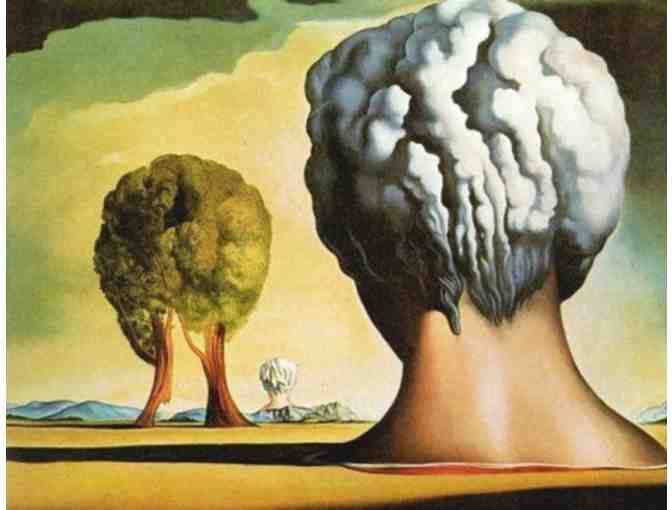"3 SPHINXS" BY SALVADOR DALI

Item Number: 1837
Time Left: CLOSED
Value: Priceless
Online Close: Sep 14, 2014 11:59 PM EDT
Bid History: 0 bids
Description
Limited Edition Giclee Print
Size: 13" x 19" (with border)
Status: Unframed
GALLERY LIST PRICE: $100-$150.00
Each reproduction is created using UV stable pigment based archival inks on Premium Picture paper, designed for the highest quality professional images, color intense, 10 mil, heavy weight, water resistant, acid-free. This unique paper provides instant drying and water resistant properties, eliminates smudging and fading, while the acid-free base materials ensure that each Inkjet Giclee print will still look great years from now.
What is the difference between a GICLEE Print
and a Poster or Standard Quality “ART PRINT”?
SURFACE: ALLOWS MUCH MORE INTENSITY of COLOR SATURATION! Posters and typical art prints use less expensive papers that do not absorb the vibrant intensity of the artists’ application of colors. GICLEE PRINTS as described above DO!!
NUMBER OF INKJETS and TYPE of INKS used: A typical print; even most lithographs are produced with a limited number/range of color inkjets. Using archival inks and a much more effective replication process with more inkjets and colors; the variables and details of each work are much better represented in accordance with how the original artist painted them.
PLEASE TAKE A FEW MOMENTS TO VISIT OUR AUCTION HOME PAGE! Click here to see hundreds and hundreds of awesome offerings ON AUCTION NOW!
* INSURED FEDERAL EXPRESS SHIPPING: $29.95
* BIDDING FOR GOOD "PERFORMANCE FEE": 9%
* CREDIT CARD PROCESSING FEE: 4%
NOTE!! The "GOOD NEWS":
USE THE BUY NOW OPTION AND YOU CAN CHOOSE UP TO FOUR A3 PRINTS IN THIS SEGMENT AND PAY ONLY ONE SHIPPING FEE OF $39.99
* In accordance with California State Law, SALES TAX APPLICABLE ONLY FOR CALIFORNIA RESIDENTS
Special Instructions
Dalí, Salvador (1904-89): Spanish painter, sculptor, graphic artist, and designer. After passing through phases of Cubism, Futurism and Metaphysical painting, he joined the Surrealists in 1929 and his talent for self-publicity rapidly made him the most famous representative of the movement. Throughout his life he cultivated eccentricity and exhibitionism (one of his most famous acts was appearing in a diving suit at the opening of the London Surrealist exhibition in 1936), claiming that this was the source of his creative energy. He took over the Surrealist theory of automatism but transformed it into a more positive method which he named `critical paranoia'. According to this theory one should cultivate genuine delusion as in clinical paranoia while remaining residually aware at the back of one's mind that the control of the reason and will has been deliberately suspended. He claimed that this method should be used not only in artistic and poetical creation but also in the affairs of daily life. His paintings employed a meticulous academic technique that was contradicted by the unreal `dream' space he depicted and by the strangely hallucinatory characters of his imagery. He described his pictures as `hand-painted dream photographs' and had certain favorite and recurring images, such as the human figure with half-open drawers protruding from it, burning giraffes, and watches bent and flowing as if made from melting wax (The Persistence of Memory, MOMA, New York; 1931).
In 1937 Dalí visited Italy and adopted a more traditional style; this together with his political views (he was a supporter of General Franco) led Breton to expel him from the Surrealist ranks. He moved to the USA in 1940 and remained there until 1955. During this time he devoted himself largely to self-publicity; his paintings were often on religious themes (The Crucifixion of St John of the Cross, Glasgow Art Gallery, 1951), although sexual subjects and pictures centring on his wife Gala were also continuing preoccupations. In 1955 he returned to Spain and in old age became a recluse.
Apart from painting, Dalí's output included sculpture, book illustration, jewellery design, and work for the theatre. In collaboration with the director Luis Buñuel he also made the first Surrealist films---Un chien andalou (1929) and L'Age d'or (1930)---and he contributed a dream sequence to Alfred Hitchcock's Spellbound (1945). He also wrote a novel, Hidden Faces (1944) and several volumes of flamboyant autobiography. Although he is undoubtedly one of the most famous artists of the 20th century, his status is controversial; many critics consider that he did little if anything of consequence after his classic Surrealist works of the 1930s. There are museums devoted to Dalí's work in Figueras, his home town in Spain, and in St Petersburg in Florida.

1904: Salvador Felipe Jacinto Dalí was born on May, 11th in Figueras, Catalonia, Spain.
1917: He started to visit the School of Art. First paintings.
1918: First small exhibition in the Theatre.
1921-25: Went to Academy of Arts in Madrid. Conflicts with his teachers.
1925: First stand-alone exibition of Dalí at the Galery of Dalmau.
1926-28: Early explorations of the Surrealism. Dalí in Cadaqués 1927
1929: Gala went into his life. Joined the group of Surrealists in 1930 Gala 1927, and Dalí 1929
1934-37: Dalí had his paranoid-critic-epoch. Dalí and Gala in 1937
1941-44: "Avida Dollars" in America.
1945-49: Dalí the Classic. Dalí and his Daddy in Cadaqués 1948
1950-65: His mystic period. He wrote several books (The secret life of Salvador Dalí).
1963-78: Dalí the Divine - Dalí and the Science.
1979-83: Theory of Disaster.
1982: Gala died.
1989: Dalí, Jan. 23th, died.